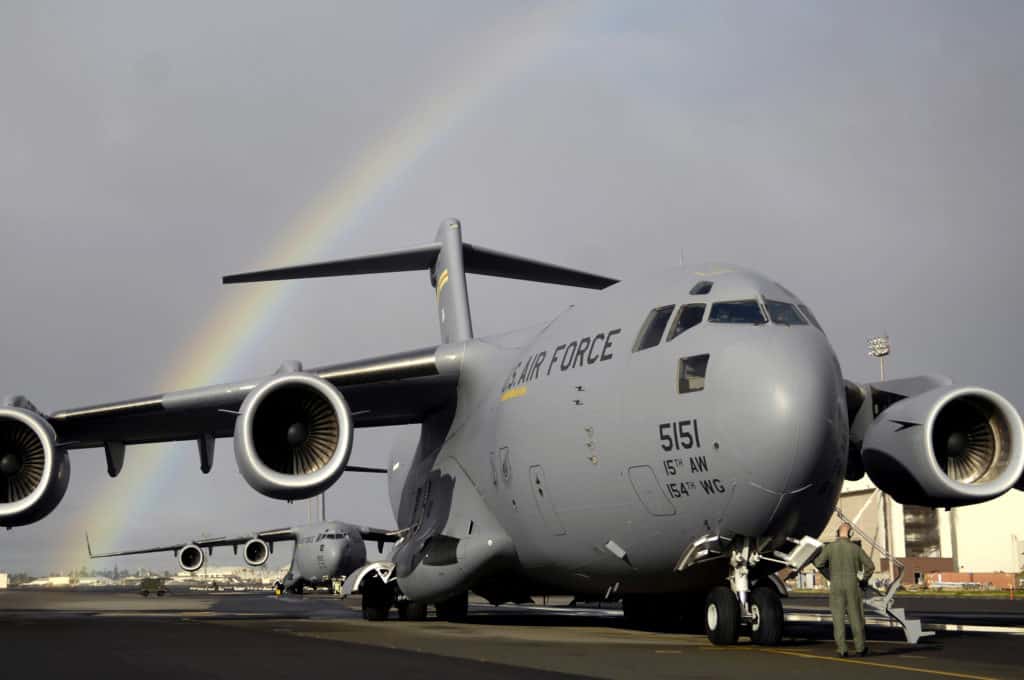
Military space available (Space-A) flights have been a major element of our strategy for saving money on our frequent travels since my husband retired from the Army in 2015. We’ve flown Space A to Europe, Hawaii, Alaska, Japan, Korea, and many places within the continental U.S.
I estimate that during our last 9+ years of world travel, we’ve saved more than $20,000 by taking military hops. Our experiences have been overwhelmingly positive, and whenever it’s a viable option, Space A (formerly called “MAC flights”) is my preferred way to fly.
Talking with others about our travels, we were surprised to realize how few military folks knew about Space-A travel, let alone had used it.
Even those who knew it was an option were reluctant to give military flights a shot. They had heard that you wait around too much, the aircraft have too many maintenance issues, or the flights are canceled at the last minute.
The bottom line is yes, those things do happen. Flying Space-A requires patience and flexibility, and it’s not a good choice for all circumstances. But if you’ve flown a civilian airline lately, you know that all those inconveniences happen with commercial flights, too. The difference is, Space-A flights are free!
This Quickstart Guide explains everything you need to know about how to fly Space-A. After reading it and following the related links within the article, you should be all set to take your first Space-A journey!
Bottom Line Up Front (BLUF): How to Fly Space-A
Here’s a summary of the Space-A flying process:
- Determine your category and any associated geographic restrictions.
- Register (aka “Sign up”) at every terminal from which you might fly.
- Monitor flight schedules at your departure bases.
- Ensure you have the documents, clothing, and gear you need.
- When you see a flight you want to take, mark yourself present within 24 hours of the time listed on the schedule.
- Show up travel-ready for Roll Call and listen for your name.
- If you are selected for the flight, collect your boarding pass and check luggage.
- If you are not selected, activate Plan B.
For more detail on each of the steps, keep reading!
If you’re NOT new to military Space-A travel, you should still read these lessons learned from our experiences and our recommended strategies for having a successful journey when taking military hops.
How Space A Flights Work
Space available flights, a.k.a “MAC flights” or “military hops,” are military operational flights that have extra seats. The military mission is the priority, and the Space-A passengers are essentially cargo.
There is no charge to fly Space-A except on Patriot Express (PE), aka “rotator” flights, for which Space-A passengers must pay a small per-person tax.
Eligible members of the military community may “hop” a flight with open seats, but the system is based on priority.
Space-A Travel Categories: Who Can Fly Space-A?
Space-A passengers are divided into six categories or “Cats:” 1 is the highest priority and 6 is the lowest.
Available seats on the aircraft are first offered to travelers in lower-numbered categories. Any remaining seats can be used by travelers in higher-numbered (lower priority) categories. Priority within a category is based on signup date, as discussed below.
Following is a partial summary of eligible travelers in each category.*
- Category 1: Emergency leave unfunded travel.
- Category 2: Accompanied environmental morale leave (EML) for sponsors traveling with or without dependents.
- Category 3: Ordinary leave for active duty members traveling with or without dependents.
- Category 4: Unaccompanied dependents on EML or whose sponsor is deployed 30+ consecutive days.
- Category 5: Unaccompanied command-sponsored and non-command sponsored dependents of service members stationed outside the contiguous United States (OCONUS). Also, members traveling under permissive TDY orders for purposes other than house hunting.
- Category 6: Retirees, Reservists, veterans with a permanent service-connected disability rated as total (100% disabled veterans), and surviving spouses of retirees and service members who died while on active duty, inactive duty training, or annual training status.
*This list of eligible passengers is not exhaustive. Other passengers, including certain civilians within the Department of Defense and DoD Education Activity teachers, are eligible to fly Space-A under various circumstances. For a complete list and more information on eligibility by category, view Table 3 in Section 4.11 of DOD Instruction 4515.13.
Important Note: Certain travelers within Category 6 have restrictions on where they can fly.
Reservists, “Gray Area” retirees (retired members of the National Guard and Reserves who are under the age of 60 and/or not yet receiving retirement pay) and 100% disabled veterans who are not also retired from the military are not eligible to fly Space-A to/from foreign countries. They can take military hops to/from U.S. states and territories.
Surviving spouses are only eligible to fly Space-A within the contiguous United States (CONUS).
The geographic restrictions for travelers within Category 6 are summarized in the table below.
Category 6 Space-A Travel Eligibility
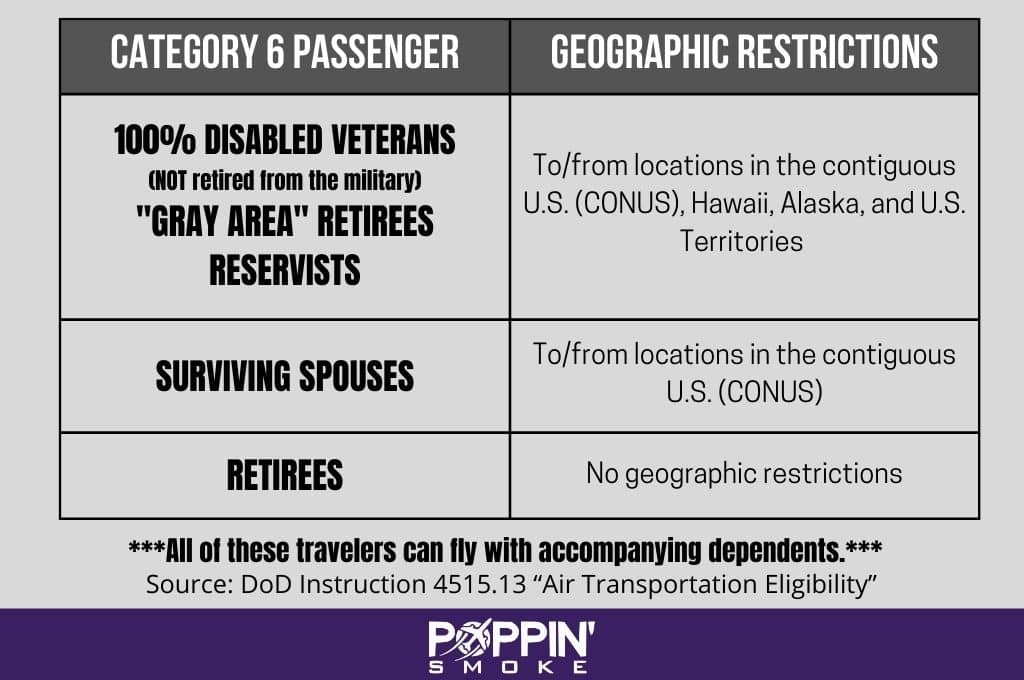
Military Dependent Space-A Travel Eligibility
Dependents of active duty service members are eligible to fly Space-A without their sponsor under certain circumstances explained here.
Dependents of retirees, Reservists, “Gray Area” retirees, 100% disabled veterans, and surviving spouses are eligible to fly Space-A, but only when accompanied by their sponsor.
The following dependents and family members are NOT eligible to fly Space-A at all:
- Ex-spouses of service members or retirees
- A service member’s or retiree’s parents, siblings, or any other family members who are not the sponsor’s dependents
Dependent children can fly Space-A with their sponsor or eligible unaccompanied parent. They are not authorized to travel with other military families.
Space-A passengers are authorized to fly with service dogs but not with pets or “emotional support” animals.
* * * Click here to print this Quickstart Guide to Space-A Flights. * * *
The Space-A Flying Process: How to Take a Military Hop
Here is a summary of how to fly Space-A.
1. Space-A Registration or “Signup”
The first step is to sign up with every military passenger terminal from which you might originate travel (including your destination). Keep in mind that you are not registering for a particular flight. You are signing up to compete for any flight with Space-A seats at a given terminal.
You can sign up in one of several different ways:
- Via e-mail (recommended)
- Using the Space-A travel app, MilSpaceA (the app is no longer available for new downloads)
- Through the AMC website’s online form
- In person at the terminal
E-mail and the MilSpaceA app allow you to sign up with multiple terminals at once. We have always used e-mail.
When signing up via e-mail, you must include all of the information listed in the “Space-A Sign-Up Options & Required Information” section of the AMC website’s Space Available Travel page (see screenshot below).
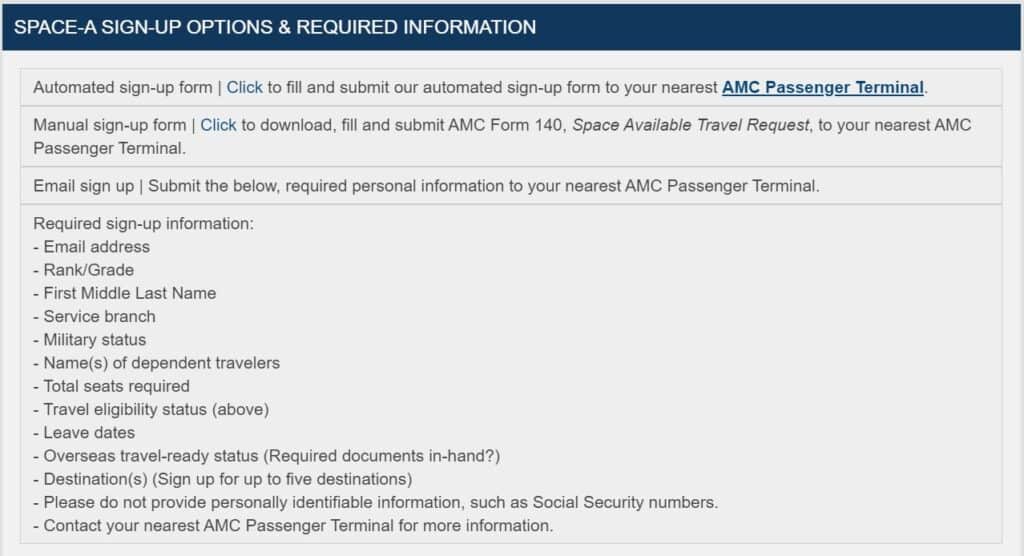
You can find current e-mail addresses for all military passenger terminals in the Passenger Terminal Directory below the Space-A Sign-Up section.
Priority within a Space-A category is based on signup date, so the earlier you sign up (maximum 60 days before your travel date at most locations, 45 days or less at some Navy locations), the better. Active duty members cannot sign up for Space-A travel until they are on leave.
| Related Reading: Space-A signup tips and examples for Category 6 passengers
Many terminals will not reply to confirm receipt of your signup. Remember to retain and print copies of the e-mails you send, because they serve as proof of your signup date.
If you want to confirm that a military passenger terminal received your signup, try calling them directly. Do not send another signup e-mail, because your place on the virtual list is based on whatever signup is most recent.
2. Tracking Space-A Flight Schedules
Track flights (also referred to as “missions”) from your desired departure base(s). Flight schedules and tentative seat counts are available up to 72 hours before a flight.
If you monitor flight schedules out of your departure base for several weeks or months prior to travel, you may see patterns in how often they have missions to particular destinations and how many Space-A passengers get seats.
| Related Reading: How to Figure Out Which Bases Fly Where
Most military passenger terminals maintain a web page or Facebook page on which they publish flight information for the upcoming 3 days. A Space-A flight schedule lists the destinations, anticipated number of Space-A seats, and the “Roll Call” time, which is the time at which passenger terminal staff announce the names of passengers selected for the flight.
(You can also obtain flight schedules by calling the terminal directly).
Many military passenger terminals also publish data on recently-departed flights, including the number of Space-A seats released.
Here is a detailed explanation of where to find Space-A flight schedules and how to read them.
3. Check-In or “Marking Yourself Present”
Within 24 hours of your target flight’s Roll Call, go to the terminal and speak with the staff to mark yourself present.
Bring the military IDs and passports (if traveling to/from a foreign country) for yourself and any dependents traveling with you. Also, bring any required paperwork, such as your leave form if you are active duty or the memo from your sponsor’s command if you are a dependent traveling unaccompanied.
DoD uniformed services ID cards are required for all passengers over the age of 14. If you are traveling with children younger than 14 who do not have a military ID card, they must have a federal, state, local, or tribal government issued ID.
When marking yourself present, you should also bring a copy of your signup e-mail in case the terminal does not have you in their system. Most terminals will accept your e-mail as proof of your sign-up date and time.
You must mark yourself present before Roll Call starts. As long as you have signed up in advance, there is no advantage to marking yourself present earlier than other passengers.
Arriving 1 – 2 hours prior to Roll Call is usually sufficient (3+ hours for a Patriot Express mission if you did not yet mark yourself present), but in the 12 hours or so before your flight, call the terminal to ensure Roll Call hasn’t changed. Calling is important because most terminals do not update their online schedules more than once per day.
Many passenger terminals have a screen or printed document near the terminal desk that displays a list of passengers who are marked present and are “competing” for the flight. Before Roll Call starts, make sure your name is on that list along with the accurate number of dependents traveling with you and your correct date of signup. If not, speak with the terminal staff.
4. Roll Call
The time listed on the flight schedule is usually the Roll Call time. When Roll Call begins, terminal staff announce how many Space-A seats are available and read the names of the passengers selected. They begin with the passengers in the lowest-numbered (highest priority) category and work their way down the list.
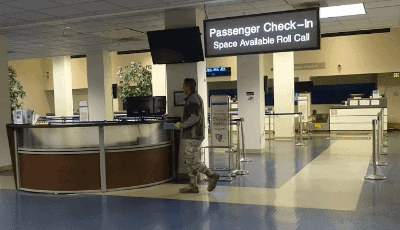
If they call your name, go to the desk and confirm that you and any dependents traveling with you are present. Show your and your dependents’ military ID cards along with the aforementioned paperwork.
After Roll Call, you might go directly to luggage check, or you may wait several more hours, but you won’t know the schedule in advance.
At the time of Roll Call, you must be “travel ready.” That means you and any family members traveling with you are in the terminal with all of your luggage and required documentation.
Don’t plan on waiting until after Roll Call to go back to your hotel or return your rental car, because you might not have time.
Note: If you’re not selected during Roll Call, stay in the terminal, at least until the flight boards. Sometimes additional Space-A seats are released at the very last minute.
5. Baggage Check
When it’s time to check bags, you, your dependents, and all of your luggage must be present.
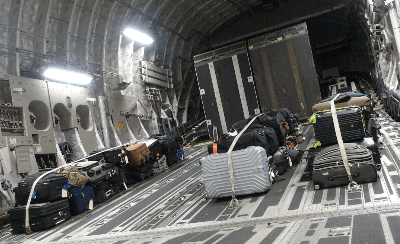
On most Space-A flights, each passenger can check two bags of up to 70 lbs each. You can also check car seats, which do not count towards your baggage allowance.
Weight limits on some smaller aircraft are as low as 30 lbs. If you cannot meet those requirements on the weight-restricted aircraft, you are not eligible for the flight.
In general, it’s a good idea to pack as light as possible when flying Space-A if you want to increase your chances of getting a seat.
Note that military passenger terminals follow Transportation Security Administration (TSA) rules for prohibited items in checked luggage.
The AMC website has more information about baggage for Space-A travelers in their FAQs.
You cannot access your checked luggage during the flight, even though you may see it strapped down right in front of you. Make sure you have everything you’ll need in your carry-on bag.
| Related Reading: What to Wear and Bring on a Space-A Flight
During baggage check, you can request a box meal if the option is available. Meals cost $5 – $10, depending on the base, and usually include a sandwich, chips, cookie, and drink. Make sure you have cash in USD and a card for payment. Some terminals only accept one or the other.
At this point in the process, you will also receive your boarding pass, which you should review carefully to ensure it lists the correct final destination (here’s why).
After you’ve checked your bags and have your boarding passes, you are “manifested” on the flight. Terminal staff will tell you the estimated boarding time, but keep in mind that it often changes without notice, so stay in the terminal.
6. Boarding
When boarding begins, all passengers go through security. Military passenger terminals follow TSA regulations, so you have the same restrictions for carry-on items as on civilian planes.
You sit in a secure area of the terminal until it’s time to board. At most locations, a bus takes you to the aircraft, and you board the plane from the tarmac.
If you are on a Patriot Express flight, your boarding pass will list your assigned seat. On other military aircraft, you select your own seats on a first-come, first-served basis. The crew may allow passengers with small children to board first, but not always.
At some point during the boarding process, crew members offer passengers foam earplugs.
7. Flight
Unless you are on a Patriot Express, which has full in-flight service, most Space-A flights are “no-frills.” The crew provides water in a cooler, but you must get it yourself.
Depending on the type of aircraft and how much space there is, you may have the option to stretch out across a few seats or even sleep on the floor. This article provides a guide to the aircraft you’re most likely to encounter when flying Space-A and explains what to expect in terms of seating, temperature, and bathroom facilities.
8. Arrival at Your Destination
After landing, passenger terminal staff will usually transport you from the aircraft to the terminal, where you collect your checked bags.
Passenger terminals generally have information and phone numbers for local rental cars, base lodging, and other resources. You can also use UJ Space A Info to quickly search for local information related to military bases around the world.
If you’ve flown to a foreign country, you may pass through customs, or you may need to go to an off-site location to have your passport stamped. The process varies by country and base.
Use Poppin’ Smoke’s Space-A Location Guides to research the customs and immigration process at your destination. The Guides also have detailed information about lodging, ground transportation, and other logistics for major Space-A hubs worldwide.
When (and When Not) to Fly Space-A
So now you know how Space-A travel works when all goes smoothly. Of course, it doesn’t always happen that way.
There are many situations when flying Space-A is not the best option. If you are going on a short vacation (less than 2 weeks) with little flexibility or you are traveling during major holidays, relying on Space-A is risky.
Most experienced Space-A travelers also avoid flying Space-A during summer PCS season (late May through early September), particularly to OCONUS destinations.
In those situations, it’s better to plan ahead and try to find cheap military flights from airlines that offer discounts or use a site like Skyscanner to find the best commercial fares.
If you are traveling solo, you have a better chance of getting a seat, even during busy periods. Many other Space-A travelers are couples or families, and even if those groups are in a higher category than you, when there is only one open seat left, a solo traveler will get it.
Packing light also increases your chances of getting a seat. Some flights have baggage weight restrictions that will take most other passengers out of the running.
You can take some of the risk out of flying Space-A and boost your chances of having a successful trip by following these strategies and tips and monitoring the Space-A flight schedules to make informed decisions about what flights are most promising.
What to Expect at Military Passenger Terminals
Passenger terminals vary widely in terms of their hours and services available. Some have a USO, a snack bar, a children’s area, and showers, while others have little more than a check-in desk and a few chairs.
Most terminals discourage passengers from getting too comfortable and falling asleep. The chairs generally have fixed armrests that prevent you from stretching out across the seats. Also, there are often signs requesting that you not lie on the floor. Come prepared with a good book and plenty of activities for the kiddos!
Many military passenger terminals have WiFi, but it’s not always very strong, so remember to download any books, movies, or activities you may want ahead of time.
Finally, keep in mind that most passenger terminals are NOT open 24 hours, so you cannot spend the night there. Even if you arrive on an aircraft that has an overnight layover, staying in the terminal is not an option. Read our tips and tricks for reserving base lodging.
Next Steps to Get Started
Now that you’ve learned all about flying Space-A, here’s what to do next:
- Determine your category and any associated geographic restrictions.
- Sign up at every terminal from which you might fly.
- Monitor flight schedules at your departure bases.
- Ensure you have the documents, clothing, and gear you need.
When you see a flight for which you want to compete, pack your bags and follow the rest of the steps in the process!
